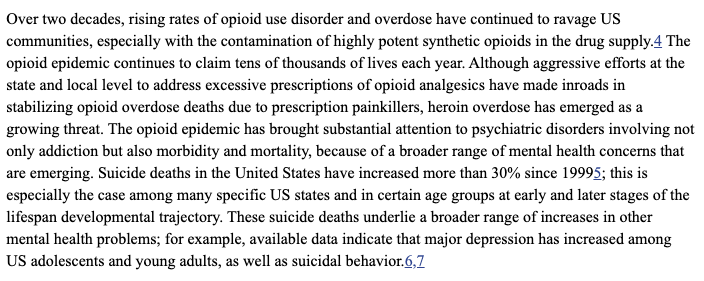Statistics on opioid and suicide epidemic.
- Type
- Academic / Technical Report
- Source
- American Journal of Public Health Non-LDS
- Hearsay
- Secondary
- Reference
Rebecca Fuhrer and Katherine M. Keyes, "Population Mental Health in the 21st Century: Time to Act," American Journal of Public Health, accessed May 14, 2021
- Scribe/Publisher
- American Journal of Public Health
- People
- Katherine M. Keyes, Rebecca Fuhrer, American Journal of Public Health
- Audience
- Reading Public
- Transcription
Over two decades, rising rates of opioid use disorder and overdose have continued to ravage US communities, especially with the contamination of highly potent synthetic opioids in the drug supply.4 The opioid epidemic continues to claim tens of thousands of lives each year. Although aggressive efforts at the state and local level to address excessive prescriptions of opioid analgesics have made inroads in stabilizing opioid overdose deaths due to prescription painkillers, heroin overdose has emerged as a growing threat. The opioid epidemic has brought substantial attention to psychiatric disorders involving not only addiction but also morbidity and mortality, because of a broader range of mental health concerns that are emerging. Suicide deaths in the United States have increased more than 30% since 1995; this is especially the case among many specific US states and in certain age groups at early and later stages of the lifespan developmental trajectory. These suicide deaths underlie a broader range of increases in other mental health problems; for example, available data indicate that major depression has increased among US adolescents and young adults, as well as suicidal behavior.
- Citations in Mormonr Qnas
The B. H. Roberts Foundation is not owned by, operated by, or affiliated with the Church of Jesus Christ of Latter-day Saints.

